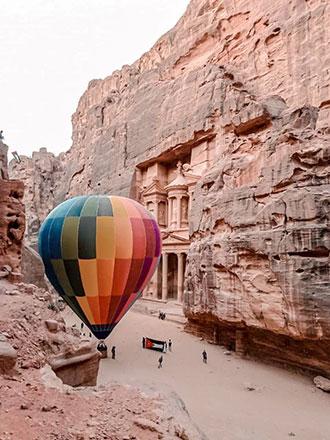You are here
E-buggies replace horse carts at Petra
By AFP - Nov 18,2021 - Last updated at Nov 18,2021

Jordanian men ride horses as tourists ride an electric cart, during their trip to the famed ancient city of Petra, some 230km south of Amman, on October 27, 2021 (AFP photo by Khalil Mazraawi)
By Mussa Hattar
Agence France-Presse
PETRA — Horses and mules have long drawn tourist carriages through Jordan's ancient city of Petra, but animal rights concerns are driving a project to start replacing them with electric vehicles.
A small fleet of 10 rechargeable e-carts now take visitors through the rose-coloured Siq or gorge leading to the famed capital of the Nabateans, which dates back to the first century BC.
"There is no pollution or smoke" and the change has "reduced the cases of animal mistreatment," said Suleiman Farajat, head of the Petra Development and Tourism Regional Authority.
The golf buggy-style vehicles have less impact because "sometimes the carriage wheels hit the sides of the Siq ... the horse dung caused a bad smell in the place, and cleaning it was not easy.
"It was an unpleasant experience for the tourists, the horses and us," said Farajat.
Animal rights group PETA, which had criticised the use of the often scrawny and overworked draft animals, has described the project as a "major first step to protect working animals".
The group hailed the "game-changing vehicles" and added that it hopes to work with officials "towards the day when there will be only animal-free transportation at Petra".
For now the Petra authority says it will keep some of the horses "to preserve the character of the place, as it is a world heritage site".
'This amazing place'
The change has however also been hailed for another reason — helping to make the UNESCO World Heritage Site far more accessible to elderly and disabled visitors.
Austrian tourist Rudy, 43, who uses a wheelchair, said he had repeatedly postponed a visit because of the COVID-19 pandemic, and was now "very happy" to have made the trip.
"Disabled people but also people who have difficulty walking for a long distance ... now have a chance to see this amazing place."
A US tourist named Angie, 60, agreed: "It seems a little bit out of character to have these in a beautiful place like this. But at our age, it was nice to come back in an electric cart."
Jordan's tourism industry is recovering from the blow of COVID-19, having previously relied on it for more than 10 per cent of its GDP. The pandemic slashed revenues from $5.8 billion in 2019 to $1 billion last year.
Petra, Jordan's most famous tourism site, provides a living for hundreds of families.
The move to replace 12 horse-drawn carriages with 10 e-carts was agreed with the horse owners' association.
Foreign tourists pay JD25 ($35) and Jordanians JD15 for the round trip from the visitor centre to the archaeological site.
The association receives 75 per cent of the income, while 25 per cent goes to the authority, said Farajat.
The head of the association, Mohammad Amarat, said those operating the electric carts earn more than JD300 Jordanian (about $423) per month.
One benefit is that the carts can carry five passengers, compared to just two in the horse-drawn carriages.
He prefers the new vehicles because previously the horses "were tired, their income was less, and the journey time was longer".
Related Articles
Regarding the article published in The Jordan Times titled "Animal welfare under scrutiny in Petra after reports of abuse" on January 18, it
AMMAN — The Petra Development and Tourism Region Authority (PDTRA) in September registered the highest number of monthly tourists since the
After years in which the COVID pandemic turned the storied "Rose City" into a ghost town, the father of seven is back at work, offering visitors rides on his decorated animals.


















